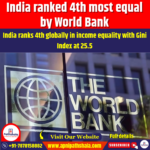World Bank ranks India 4th among the World’s Most Equal Societies
General Studies Paper I: Poverty and Developmental Issues, Social Empowerment, Urbanization |
Why in News World Bank ranks India 4th among the World’s Most Equal Societies?
Recently the World Bank placed India fourth on its list of the world’s most equal societies in “Spring 2025 Poverty and Equity Brief”. It spotlights India’s social policies and prompts re‑evaluation of development strategies in light of measurable equity gains.
Key Highlights of Spring 2025 Poverty and Equity Brief
- The World Bank issued its Spring 2025 Poverty and Equity Brief in April 2025.
- The Brief covers poverty, shared prosperity, and inequality in over 100 developing countries.
- The report uses data from national surveys and international standards to ensure global comparability.
- It enables apples-to-apples evaluation across countries and regions.
- It supports global goals like the Sustainable Development Goals on poverty and inequality.
- It keeps poverty reduction visible during Spring and Annual Meetings of the World Bank and IMF.
- The Brief tracks poverty at four income thresholds:
- Extreme poverty under $2.15/day (2017 PPP).
- Lower-middle-income poverty at $3.65/day.
- Upper-middle-income poverty at $6.85/day.
- National poverty lines for each country.
- The Brief uses Indicators:
- Poverty headcount rates and counts at four income thresholds.
- Gini index for inequality.
- Bottom 40% income share for shared prosperity.
- Multidimensional poverty measures including non-monetary factors like health and education.
- Top 4:
- The Slovak Republic achieved the lowest Gini, near 24.1.
- Slovenia stands close in second place around 24.3.
- Belarus holds the third spot with a Gini near 24.4.
- India ranks fourth with a Gini of approximately 25.5.
- Sub‑Saharan African nations show the highest poverty shock and inequality. Some nations in this region experience extreme poverty rates above 45% along with high inequality levels.
India’s Performance in Spring 2025 Poverty and Equity Brief
- India achieved the fourth position globally because its Gini value dropped to 25.5 in 2022.
- India improved its Gini index from 28.8 in 2011 to 25.5 in 2022.
- India now ranks ahead of major economies like China at 35.7 and the US at 41.8.
- Among G7 and G20 nations, India now leads in achieving the highest income equality.
- India now joins the group of nations with the lowest inequality in the world.
- This highlighted how India outperformed major economic powers like the US and China in income equality.
- India recorded a drop in extreme poverty from 16.2 % in 2011–12 to 2.3 % by 2022–23, using the $2.15/day measure.
- India lifted around 171 million people out of extreme poverty between 2011 and 2023.
- It moved from a “moderately unequal” bracket in 2011 to a “moderately low inequality” bracket by 2022.
- This major reduction shows more equal income distribution across the population.
- It also reflects the effect of policy-driven poverty reduction and welfare initiatives.
Policy Reforms That Helped Bridge Inequality in India
- Financial Inclusion: The government launched PM Jan Dhan Yojana in 2014 to expand banking access. As of June 2025, over 55.7 crore individuals gained access to bank accounts through this initiative. It enabled citizens to receive direct subsidies and build savings. It increased women’s participation, with over 55 % of accounts owned by women.
- Digital Identity: By July 2025, Aadhaar had generated more than 142 crore biometric identity numbers across the country. It linked welfare schemes to individuals via biometric authentication. India launched the Direct Benefit Transfer mechanism in 2013 to streamline subsidy payments. It secured ₹3.48 lakh crore in subsidy savings by March 2023.
- Healthcare Outreach: The Ayushman Bharat Yojana launched in 2018 to cover hospital costs. As of July 2025, the Ayushman Bharat scheme had distributed 41.34 crore health cards. It secured coverage of ₹5 lakh per family with 32,000 empanelled hospitals. The Vay Vandana scheme extended coverage to all citizens aged 70+. This scheme cut out‑of‑pocket expenses from 62 % to 38 %.
- Food Security: The PM Garib Kalyan Anna Yojana began in 2020 to provide free grains. It reached over 80.6 crore people by December 2024. Aadhaar-based ration verification eliminated 5.8 crore fake cards. This effort ensured food aid reached the most vulnerable populations.
- Entrepreneurship: The Stand‑Up India scheme began in 2016 for SC/ST and women entrepreneurs. It approved 2.75 lakh loans totaling ₹62,807 crore by July 2025. The PM Vishwakarma scheme started in 2022 for artisans. By July 2025 it registered 29.95 lakh artisans. These programs empowered disadvantaged groups in rural economies.
- Farmer Welfare: The PM‑KISAN program started in 2019 to support small farmers. By 2025 it reached over 11 crore farm families. The initiative provided ₹6,000 annually to each household. This support improved rural livelihoods and reduced agrarian inequity.
- Infrastructure: The Swasth Bharat scheme began in 2021 to strengthen health infrastructure. It allocated ₹64,180 crore through 2025–26. It enabled expansion in medical colleges and public hospitals. Over 2,000 ASHA health workers received new training in 2025. They increased maternal registration to 71 %, with 85 % institutional births.
Gini Index and Palma Ratio
- Gini Index: The Gini Index is used to assess how unevenly income is shared within a country. It ranks values from 0 (perfect equality) to 1 (perfect inequality). A score near zero shows incomes are nearly equal. The index uses income pair differences and normalizes by mean income.
- Formula: The Gini calculation uses the difference between the Lorenz curve and a line showing perfect equality. The Lorenz curve plots cumulative income share versus population share. The proportion A/(A+B) gives the Gini value. A slope near the diagonal means equality. When the Lorenz curve shifts far below the diagonal, it signals greater income disparity.
- Interpretation: A low Gini value suggests broad income sharing. It implies middle-income groups receive their fair share. It also reflects strong redistribution and welfare systems. High Gini values mean a few control most income. They often highlight weak tax systems or limited social safety nets.
- Palma Ratio: The Palma ratio compares income of the top 10% to the bottom 40%. It states that about half of national income goes to the middle 50%. A Palma score over 1 shows that the richest 10% earn more than the bottom 40% combined. This measure highlights extremes of distribution more clearly.
Why Does This Ranking Matters for India?
- Enhanced Global Reputation: India’s fourth-place ranking boosts its reputation globally. It signals that the country prioritizes equitable growth. It positions India as a model for inclusive development. It elevates India’s standing among investors and international bodies. This achievement reflects stable progress in inequality reduction.
- Investment Appeal: Global investors seek markets with shared prosperity. India’s strong ranking reassures investors on social stability. Balanced income reduces social unrest and foster’s market confidence. Firms may respond with increased capital for sustainable ventures. This may lead to higher foreign direct investment inflows in 2025–26.
- International Partnerships: Countries and global institutions value equity-focused partners. India’s position can help win development support and aid. It may gain greater voice in G20, IMF, and World Bank discussions. This standing aligns with India’s growing role in international forums.
- Sustainable Growth Agenda: Equity supports sustainable long-term growth goals. It ensures growth benefits reach wider sections. It helps align India’s development with Sustainable Development Goals. It encourages balancing wealth with social wellbeing. It sets a blueprint for other emerging economies.









